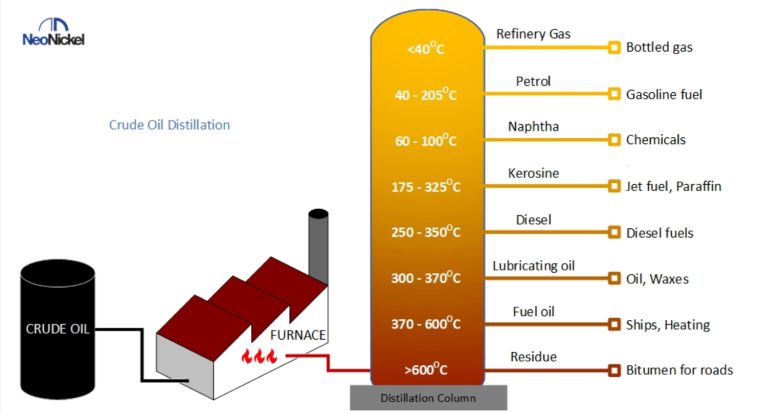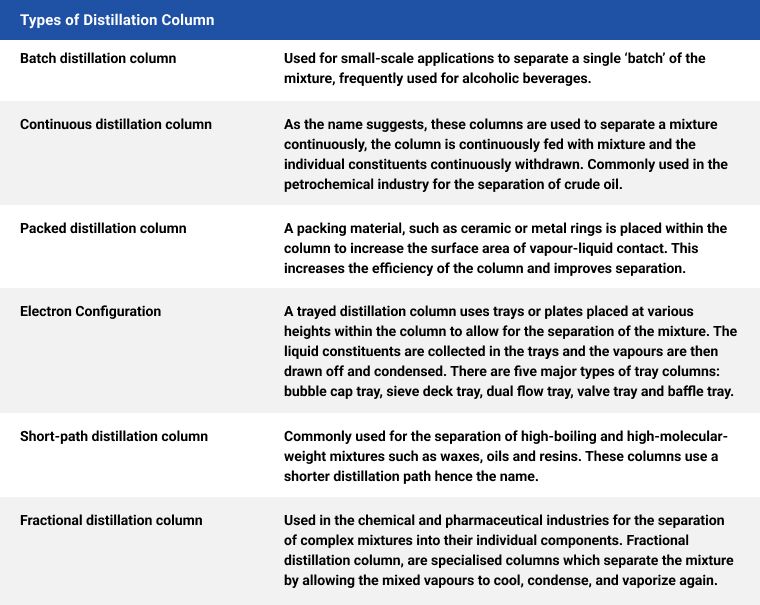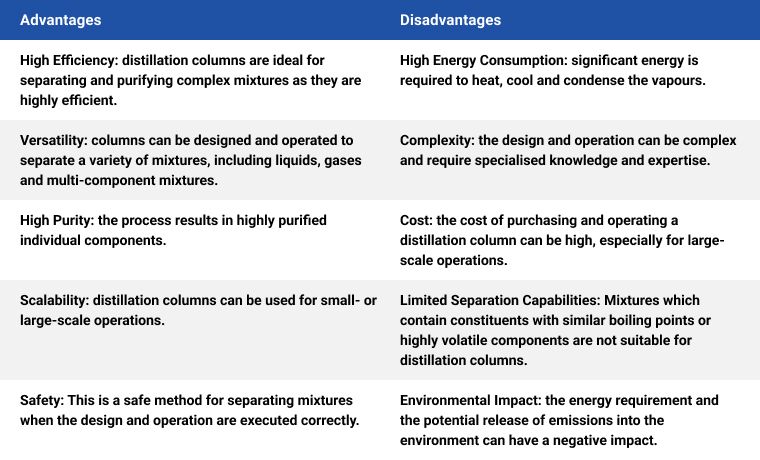Distillation Columns
What is a distillation column?
A distillation column, or tower, is used to separate liquid mixtures into individual constituents based on their boiling points. The liquid is heated to produce vapours which are then condensed, by cooling, back into liquid form. The liquids are then collected in trays or plates positioned at different heights inside the column, their position based on the boiling point of each separate component.
Distillation columns are used in petrochemical, chemical and pharmaceutical industries to purify and separate various chemicals, distillation columns are also used in the production of alcoholic beverages.
The design and specific operation of a distillation column can vary greatly depending on the type of liquid mixture being distilled and the desired product specifications.

Key Purposes of a Distillation Column
A distillation column is essential for various industrial processes where the separation and purification of liquids is required.
✓ Purification: It is used to purify liquids by separating impurities and desired products based on their boiling points.
✓ Fractional Distillation Column: In industries like petroleum refining, it separates crude oil into fractions like gasoline, kerosene, and diesel.
✓ Concentration: It concentrates substances by removing less volatile components, commonly used in the production of spirits and essential oils.
✓ Recovery: The column can recover specific components from waste streams, playing a role in recycling and environmental management.
Types of Distillation Column

Pros and Cons of Distillation Columns

FAQs
What is the purpose of a distillation column?
A distillation column is a critical piece of equipment used primarily in the chemical processing industry to separate mixtures into their parts or fractions. This separation process is fundamental in the production of pure components from various mixtures.
How does a separation column work?
The column works on the principle of differential distillation, where a mixture is heated to create vapours. These vapours then ascend the column, which is cooler at the top than at the bottom. As the vapours rise, they cool and condense at different levels according to their boiling points. Components with lower boiling points condense higher in the column, while those with higher boiling points condense lower down.
What are the two types of distillation columns?
Both tray and packed columns are integral to the distillation process, with their selection depending on factors such as the nature of the mixture being separated, desired purity levels and process efficiency requirements.
Tray Column
Structure: This type features a series of trays or plates stacked within the column.
Operation: As the vapour rises through the column, it interacts with the liquid on these trays, facilitating the exchange of heat and mass.
Types of Trays: They can have various tray designs like sieve trays, bubble cap trays, or valve trays, each with unique efficiency and flow characteristics.
Applications: Tray columns are widely used in industries where precise control over the separation process is required, such as in petrochemical refining or the manufacture of fine chemicals.
Packed Column
Structure: Instead of trays, these columns contain a packing material, which can be either random (like rings or saddles) or structured (layered mesh or corrugated sheets).
Operation: The packing increases the surface area for contact between the vapour and liquid phases, enhancing the separation process.
Efficiency: Packed columns are generally more efficient for lower-pressure drops and are better suited for heat-sensitive materials.
Applications: They are commonly used for distillation processes that require a large number of theoretical stages, such as in air separation or the production of fine fragrances.
Each type offers unique advantages, making them suitable for various industrial applications.
What does a distillation column consist of?
A distillation column is a sophisticated piece of equipment essential in the separation of liquid mixtures into their components. It consists of several key components, each playing a vital role in the distillation process:
Vertical Shell: The main body of the column, typically tall and cylindrical, where the separation of liquids occurs.
Reboiler: Situated at the base of the column, the reboiler heats the liquid mixture, causing it to vaporize and ascend the column.
Condenser: Located at the top, the condenser cools the vapour, causing it to condense into a liquid. This liquid can be collected or returned to the column as reflux.
Trays or Packing Material: Inside the column, there are either trays (also known as plates) or packing materials. Trays allow for the interaction between vapour and liquid, facilitating the separation process, while packing materials increase the surface area for vapour-liquid contact.
Feed and Withdrawal Points: The feed point is where the mixture to be separated is introduced. Withdrawal points are located at various heights for removing the separated components, known as fractions.
Reflux Drum: This component collects the condensed vapour from the top of the column. Part of this liquid (reflux) is returned to the column to achieve better separation.
Control Systems: These include temperature and pressure monitors and controllers that manage the conditions within the column to optimise the distillation process.
Supports and Insulation: Structural supports ensure the stability of the column, and insulation helps maintain the necessary temperature gradients.

